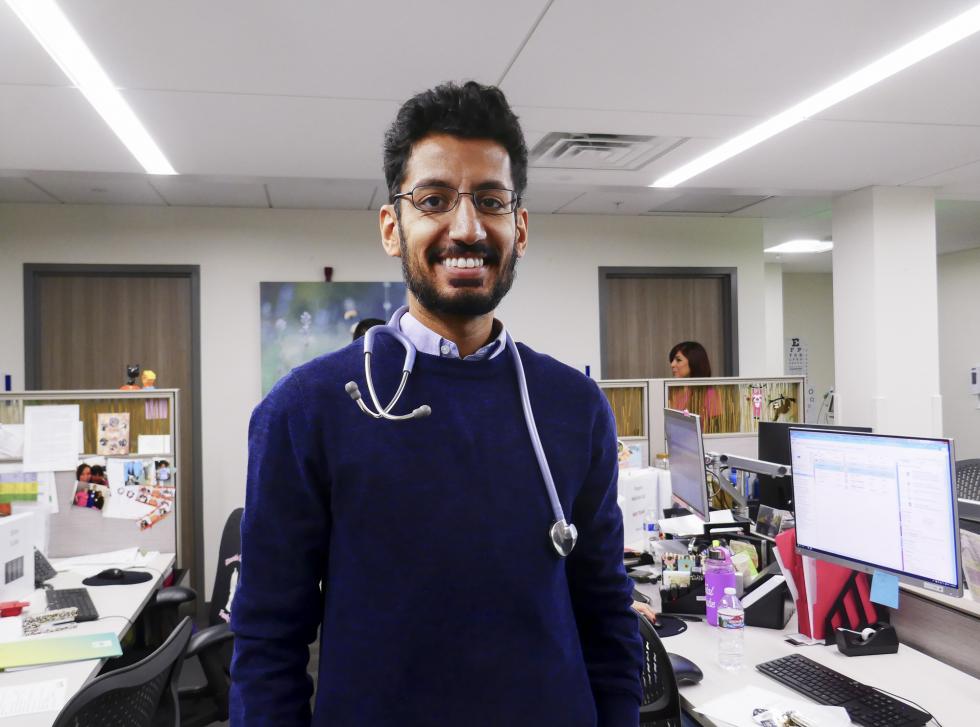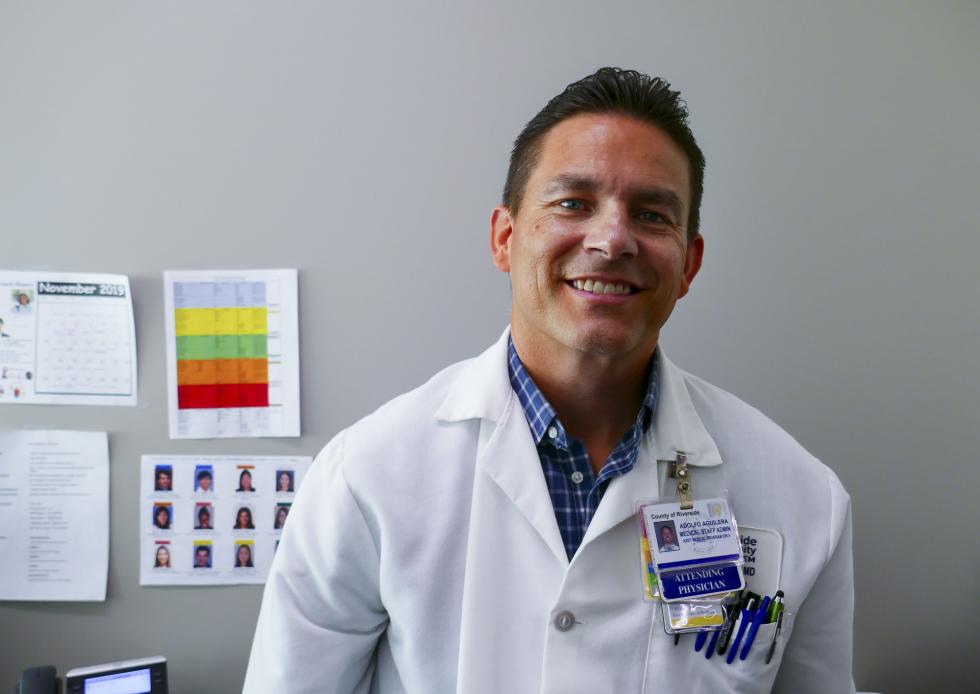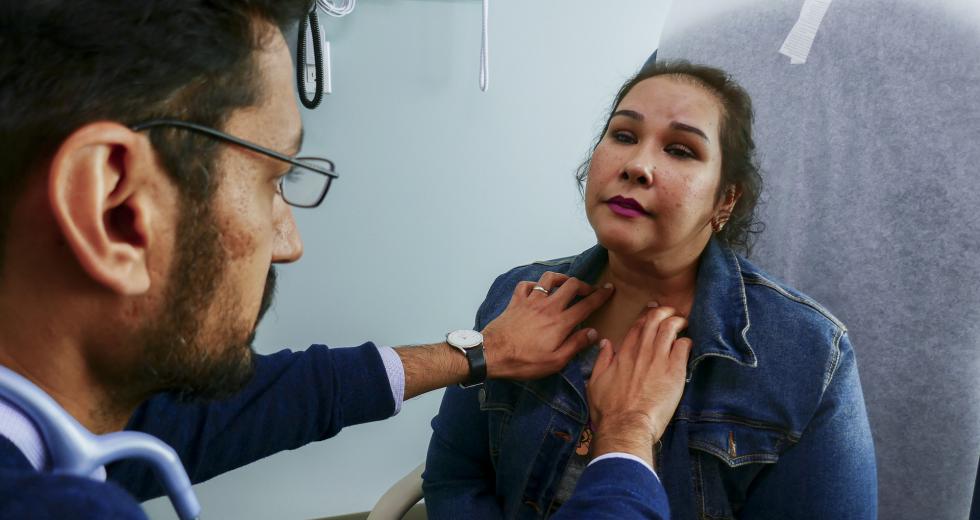Primary care doctors are a hot commodity across California.
Students are being lured by full-ride scholarships to medical schools. New grads are specifically recruited for training residencies. And full-fledged doctors are being offered loan repayment programs to serve low-income residents or work in underserved areas.
These efforts are intended to ease or stave off the physician shortage expected to peak within the next decade in California. By 2030, the state will be short some 4,000 physicians, according to a study from the HealthForce Center at UC San Francisco.
The shortage is already acute in rural and inner city areas, especially in the Inland Empire of Southern California where the number of physicians needs to double just to reach the recommended amount to serve the fast-growing population.
“The Inland Empire region has one of the lowest ratios of physicians, including primary care physicians, and that creates a number of challenges,” said Dr. Geoffrey Leung, ambulatory medical director for the Riverside University Health System. “ When we have delays in care, that can result in sort of chronic illnesses or acute illnesses that become worse.”
With high student loans, medical school grads have been turning to better-paying specialties instead of primary care, such as family practice, pediatrics or obstetrics, leaving some areas in dire need.
“In California in particular, what’s unique is that the total number of physicians isn’t as big of a problem as where they are located,” said Mark Henderson, professor of internal medicine and associate dean of admissions at the UC Davis School of Medicine. “It’s really a maldistribution problem.”
Health insurers, medical professionals and community leaders are working on solutions. This summer, the state offered 250-plus doctors loan repayment plans in exchange for ensuring 30% of their caseloads were Medi-Cal patients.
Meanwhile, insurer LA Care is spending millions on recruiting new doctors and, in South Los Angeles, the Martin Luther King Jr. Community Hospital is working to create a new residency program. In the Inland Empire, leaders are working to create a “middle school to medical school” pipeline.
Because doctors tend to practice near where they trained, where they are from or where they have a family connection, resources are being poured into the expansion or creation of training programs that are situated where the need is.
Most Impacted Region In The State: The Inland Empire
Inland Empire officials have been working on this for quite some time. A statewide report from The Future Health Workforce Commission released this year found the number of physicians is 35 per 100,000 people, compared to the recommended 70 doctors, making it the most impacted region in the state.
Because of that need the state approved a new University of California medical school that opened in 2013 at UC Riverside specifically to train doctors to serve the local area. It offers scholarships to students who promise to return after residency to practice in the area and reaches out to kids interested in health careers.
The county and medical school have partnered to expand long-standing residency programs by inviting more students to train in the area. And both institutions recruit with an eye toward geographic nativity, meaning if an applicant is from or has a connection to the area they get priority.
For cancer survivor Cesilia Jimenez these efforts by the county are paying off.
Recently Jimenez received the results of her latest scans at the Moreno Valley Community Health Center from Dr. Moazzum Bajwa.
She had been putting it off.
“I’ve been so nervous to hear those results, I knew I wanted to hear them from you,” she told Bajwa after he assured her that everything on the scans looked good.
It was Bajwa, who was a resident at the time, who diagnosed a cancerous tumor in her neck and got her treatment for it after she had sought answers for years as to why she was losing her ability to walk.
Now, he is an attending physician and teaching residents through Riverside University Health System and the UCR medical school. Bajwa is considered a success story in Riverside County’s efforts to grow, recruit and retain primary care doctors in the region.
Dr. Moazzum Bajwa completed his residency with Riverside County’s
University Health System and stayed on as a full-fledged
physician and faculty member of the residency. (Photo by
Elizabeth Aguilera for CalMatters)

So far the county is seeing success, Leung said. About four out of 10 residents stay in the Inland Empire after their training and eight to nine stay in Southern California. While those numbers are not that different from other programs across the state, opening the medical school and expanding training slots have kept doctors in the area.
Dr. Takesha Cooper is on the admissions committee at the medical school, where priority is given to applicants who have a permanent or active mailing address in the area or went to college or attended high school in the Inland Empire.
“We do a holistic review and don’t just look at test scores,” she said. “We call it mission fits.”
Cooper defines it as applicants with connections to the area and who believe in the school’s mission to help the medically underserved region and train a diverse workforce of physicians. “We have to focus and attract and try to keep people who are growing up in this area, who have ties and are more likely to stay,” she said.
So far, the medical school is seeing early success. Of its 128 graduates, about 31 percent are training as residents in the Inland Empire.
“I Needed To Serve This Population“
Cooper is the kind of local student the school hopes to capture.
She grew up in Moreno Valley long before the medical school opened. She went away for college, completed medical school at the University of Southern California and moved to the Bay Area for her residency and a fellowship in child and adolescent psychiatry.
And, as statistics bear out, she set up her practice in Palo Alto, near Stanford where she finished her training.
“I did that for five years but I started to feel like I’m not really needed here,” she said. “My heart told me I needed to serve this population.”
So she came back to Riverside to practice and then she joined the faculty at UCR and has since helped start a residency in general adult psychiatry and a fellowship in child psychiatry as a way to train and keep much-needed mental health professionals in the area.
“If our residents had to go to UCLA or UC San Diego or Irvine, chances are they would have stayed in that area and practiced,” she said. “It’s what I did.”
Dr. Adolfo Aguilera is associate director of the Riverside County
University Health System and University of California School of
Medicine residency program and physician in charge at the Moreno
Valley Community Health Center. (Photo by Elizabeth Aguilera for
CalMatters)

It’s the same strategy the county uses in recruiting medical school graduates like Bajwa to its residency programs, said Dr. Adolfo Aguilera, associate director of the University Health System residency program, who also stayed on after he trained in Riverside more than two decades ago.
“When somebody has a connection to the area, you know, they are invested in what they’re going to be doing,” he said. “If they’re here to stay, they’re going to want to make sure that they are providing the best care that they can, that they are essentially trying to build the program so that we’re able to outreach to our community and serve their needs”
Bajwa is from the East Coast but the program’s goals matched his when he interviewed and Riverside was his first choice. He also had another reason for coming and staying: His wife is from Riverside and she’s also a physician.
“The connection with my wife is what brought me out here first,” he said. “But it was the community and identity of building something bigger than myself that I fell in love with.”
That’s what Leung, Aguilera and others in Riverside hope will happen with many of the students and residents they recruit. And they are not alone.
Recruiting Physicians Where They Are Needed
This kind of thinking is happening across the state in areas lacking physicians.
In Northern California, UC Davis has partnered with the Oregon Health and Science University in Portland and created a program called COMPADRE, or California Oregon Medical Partnership to Address Disparities in Rural Education. It focuses on the area between Davis and Portland to recruit kids to medical school and to provide a program that allows them to train where they are from.
“We’ll modify their curriculum to allow them to remain in their home community for a large part of their training to keep them connected to a community health center in the region,” Henderson said. “If we get physicians who actually grew up or have a connection to these communities they will be less burned out and will have meaningful relationships to the community and the hospital.”
In urban South Los Angeles, the MLK Jr. Community Hospital set up its own medical group in 2016 that recruits and hires physicians to practice in the neighborhood and is slated to start a residency training program in 2022, said Elaine Batchlor, CEO of the hospital.
“The strategy is to recruit doctors who have an interest in working in underserved communities, to offer them a state of the art practice environment with high quality colleagues,” she said. “We offer market compensation and the possibility of having loans forgiven because they are working in a medically underserved area.”
Bringing residency slots to communities is a strategy that costs money. These slots are usually paid for by the Medicare program but the federal government has not created new residency positions in years. So the program at MLK and other new training sites are being funded by the host institutions or insurers like LA Care Health Plan.
LA Care serves 2 million Medi-Cal patients in Southern California. Last year the insurer committed 5 percent of its reserves, about $31 million a year for five years, to a program called Elevating the Safety Net, said John Baackes, CEO of the organization. It includes scholarships for medical school students, funding for residency slots, grants to clinics and private practices to recruit primary care doctors into Los Angeles County and loan repayment up to $180,000 for those newly recruited physicians who stay three years.
“We’re hoping that when their three years is up they will have fallen in love with L.A. and their practice and they’ll stay on with us,” Baackes said. “We’re aimed at the safety net populations, those people who are on Medi-Cal or uninsured, and we think this is the right thing to do is invest in the future of this population.”
In Riverside, the residency program that produced Dr. Bajwa is also partly supported by the county. Riverside County funds 52 positions beyond what the federal government provides.
“We are over our cap, which means every resident that we add on top of that limit are entirely funded through the county,” said Leung, of Riverside University Health System. “Any improvement that we make in the Inland Empire area whether it is in workforce, education or in terms of policy or the way we think about developing neighborhoods, all of those things help make the Inland Empire the sort of area that people want to move to and that help us with recruiting doctors, resident physicians and medical school students.”
For patients, having access to a doctor over the long term that they know and trust pays off.
Before Dr. Bajwa, Cesilia Jimenez never knew who she was going to see at the clinic.
“It feels good to just come and he knows what we are going to talk about and not me explaining to the doctor what I’ve been through,” she said.
When she left their appointment Bajwa gave her a hug before she walked out on her own.
“Many programs talk about serving the underserved but here the focus that the faculty have on actually taking care of the community and doing outreach in the community is just unparalleled I think,” Bajwa said. “That was something I wanted to be a part of.”
—
CalMatters.org is a nonprofit, nonpartisan media venture explaining California policies and politics. Comstock’s is a CalMatters media partner.



